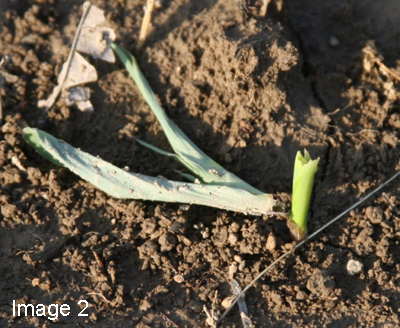
Black cutworm moths have been active across some areas in the Midwest with significant moth counts reported in some counties in IL, IN and Iowa. As of 05-15-19 Illinois has reported significant flights in Madison, Fayette, Warren, Champaign and Peoria counties with estimated cutting dates of May 10th, 20th, 21st, 25th and June 4th respectively. In Indiana the counties of Adams, Allen, Clinton, Dubois, Fayette, Fountain, Hamilton, Hendricks, Jay, Montgomery, Pulaski, Putnam, Shelby, Sullivan, Tippecanoe, Tipton and Whitley have all reported significant moth captures. Iowa has also reported significant flights with estimated cutting dates ranging from May 17th to May 23rd across the state. Missouri has not reported any significant black cutworm flights yet. You can follow Missouri’s pest monitoring network here: https://ipm.missouri.edu/pestMonitoring/bcw/index.cfm
The date when a significant flight occurs marks the biofix; the date when the degree day accumulation calculation starts for black cutworm, which provides some guidance on scouting activities. The degree days are calculated for a 24-hour period and accumulated (summed) over a period of time using the formula: [(maximum daily temperature + minimum daily temperature)/ 2] -50. How do we estimate the potential cutting date? The cutting damage to corn (when the base of seedlings is clipped off at about soil surface Image 1) begins when 300 pest degree days have accumulated following the first significant moth capture. A significant moth capture will be followed by an egg laying period. Areas with green vegetation (where burndown or pre-emergent herbicides were not applied due to weather conditions) are preferred sites for egg laying by the females. Additionally, delayed corn planting this spring will increase the risk of damage so be sure to scout from VE-V5.
Feeding damage may be patchy, so scout multiple locations and check for signs of leaf feeding, cutting, wilting, and missing plants. Record the number of cut plants and the number and size of larvae found per 100 plants. The risk of yield loss decreases as the plants get larger, the larvae approach maturity, and surface soils are dry. During the leaf feeding stage, control may be warranted if 3-5% of plants show leaf feeding and 2 or more cutworms are present per 100 plants. As larvae get larger and begin to cut plants, a simple threshold of 3% cut plants and larvae still present and actively feeding may be used to trigger a rescue insecticide.
For more up to date information on black cutworm activity, scouting or rescue options contact your local FS crop specialist. Happy Scouting!
Image- Corn plant cut by black cutworm (Source: GROWMARK,Inc.).